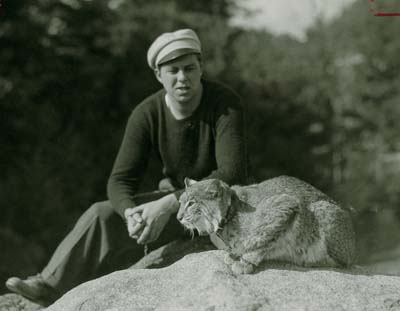 |
 |
| current issue |  |
past issues |  |
send a letter/news |  |
address update |  |
advertise |  |
about us |  |
alumni home |
On Ben's Farm
The Nine Lives of UNH's Wildcatby Mylinda Woodward '97
 The Late C. Philip Shannon '36, president of Lambda Chi Alpha, was the trainer for Butch I, UNH's third wildcat mascot.
The Late C. Philip Shannon '36, president of Lambda Chi Alpha, was the trainer for Butch I, UNH's third wildcat mascot.
|
"Go, Durham Bulls!" The cheer doesn't sound familiar, but it nearly came to pass: 78 years ago, a bull was almost elected the UNH mascot. Other contenders on the ballot in the Feb. 4, 1926, edition of The New Hampshire were a husky, an eagle and even a unicorn. But when the votes were tallied, the majority of students believed that the speed, litheness, cunning and resourcefulness of the wildcat were also to be found in the UNH athletic teams. (In practical New Hampshire, some students may have been persuaded by the additional argument that a wildcat could be "more easily transported from place to place than a bull.")
Several months later, students heard that a farmer in Meredith, N.H., had captured an adult wildcat. The senior honor society Blue Key took up a collection, and an alumnus and two students were dispatched to purchase the cat. On the drive back to Durham, Cupe Osgood '14, Eddie Simpson '29 and Gil Reed '30 shared the front seat of the touring car; the wildcat sat in back, caged and yowling and trying to claw her way out of a wooden box. Halfway home, Reed slid his hand along the seat back, and giving his best imitation of a wildcat screech, jabbed Osgood in the neck. Osgood promptly jammed on the brakes, jumped out of the car and ran into a cornfield, leaving Reed and Simpson dissolved in laughter.
Maizie made her debut at the 1927 Homecoming game, but died in 1929. Bozo was purchased in 1932 but disappeared the following spring. The students' plan for the third cat, bought in 1934, was to name him after the first New Hampshire player to score in the game against Maine. But should it be Henry, for the player who kicked the first field goal? Or Charles, for the player who made the first touchdown? A compromise, Butch, solved the crisis.
At football games, the cats were led with a chain leash and a stick, but they disliked the noise, and the sight of the frightened animal was more distressing than inspiring to many fans. Butch IV was purchased in 1940 but lived only a week. Finally, Blue Key members took to heart the advice of a student who said keeping a wild animal as a mascot was, "in view of the net results, very unwise."
Other than the brief appearance of a fan's pet wildcat at football games in 1970, UNH's only live mascot since has been Wild E. Cat, the 6-foot-tall furry cheerleader. Maizie is still with us, stuffed, mounted and on display in Dimond Library. Another 'Cat is in the works, however—a wildcat sculpture, which the Alumni Association tentatively plans to unveil on campus in June 2006.
Only once did a UNH wildcat mascot suffer the indignity of being kidnapped by a rival college. In 1939, a week before a game against Harvard, Butch III was discovered missing from his cage behind the Lambda Chi Alpha fraternity house. Both Tufts (which had just lost to UNH) and Harvard were considered likely culprits, but searches for the cat in Boston and Cambridge came up empty. Three days later, an insurance salesman was surprised to find the wildcat in his garage in Woburn, Mass., abandoned in a small carrying box. The cat was hungry and thirsty but otherwise unharmed. Despite the fact that in large letters on top of the cage was written "HARVARD 60, N.H. 0," Harvard denied any involvement, stating that they had enough cats at Harvard already without adding a wild one to the collection.
Mylinda Woodward '97 is the assistant university archivist.
blog comments powered by Disqus

